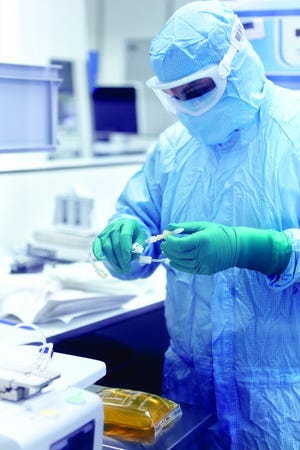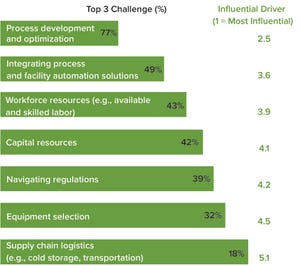April 2021 Featured Report
A process operator prepares connecting hose for later use in a production process at the Novartis biomanufacturing facility for innovative cell and gene therapies in Stein, Switzerland (
https://www.novartis.com
)
As editors, we are fortunate to have the opportunity to listen to biopharmaceutical developers and innovators discuss the intricacies of their work. Typically, we find that the best discussions come from asking two fundamental questions: What need did you observe in the industry that drove your work, and what technologies would help you do your job better? Over the past five years or so, the answers have shifted. Cell and gene therapy (CGT) innovators are focusing on increasingly complex diseases and indications. The preference for off-the-shelf allogeneic products is still present, but developers also are not shying away from providing autologous products exclusively.
Although most CGT companies have established processes, they still depend heavily on manual operations and single-source supply ...
Regenerative medicine is the interdisciplinary field comprising tissue engineering, cell therapy, and gene therapy. These biopharmaceutical modalities, also referred to as
advanced therapies
, are growing rapidly, characterized by groundbreaking therapeutic advances that have the potential to change how healthcare providers deliver care. As Figure 1 shows, cell and gene therapies have gained traction over the past decade, as evidenced by large increases in investment and the number of marketed products. By contrast, tissue engineering investment and product commercialization has lagged (
1
). More than 1,000 companies are developing cell and gene therapies, but only about 130 of them are exploring tissue-engineered medical products (TEMPs) as a viable source of regenerative therapeutics.
Figure 1: Temporal comparison of cell therapy, gene therapy, and tissue engineering (data from the Alliance for Regenerative Medicine, July 2020)
Based on our analysis, we believe that the delayed maturation of tissue-en...
Figure 1: Average commercial manufacturing challenge
From large-scale manufacturing of one-size-fits-all blockbusters to small-scale processing of personalized therapies, the biopharmaceutical industry has undergone a revolution over the past decade. Among the standout milestones is the development of advanced therapy medicinal products (ATMPs). More than 1,000 of these research-intensive therapies are progressing through clinical trials toward potential commercial manufacturing. Cell and gene therapies (autologous and allogeneic) are targeted for many incurable diseases and conditions, including autoimmune disorders and cancers. Despite the excitement about ATMP potential, developers and manufacturers are facing sizable difficulties, according to survey data collected by CRB for its
Horizons: Cell and Gene Therapy
report (
https://go.crbusa.com/2020-horizons-atmp
) (Figure 1). Our study finds
Our study data were collected from nearly 150 industry leaders and reflect the need for manufacturers to design...
The US Food and Drug Administration (FDA), the European Medicines Agency (EMA), the Medicines and Healthcare Products Regulatory Agency (MHRA), and Japan’s Pharmaceutical and Medical Devices Agency (PMDA) all offer support and guidance for developers of advanced therapy medicinal products (ATMPs). Some agencies have issued guidelines to help companies through different stages of product development — from research and development to marketing authorization and postauthorization activities. Such guidelines are updated regularly as more knowledge becomes available from the development and approval of new ATMPs. For example, the EMA guidelines now have draft guidance for investigational medicinal products and for authorized products (
1
), and the FDA has issued guidelines on the development of gene therapy products (
2
).
Regardless of the region, regulators expect ATMP developers to comply with current legislation on good manufacturing practices (GMPs), good clinical practices (GCPs), and good laboratory p...
Subscribe to receive our monthly print or digital publication
Join our 70,000+ readers. And yes, it's completely free.









